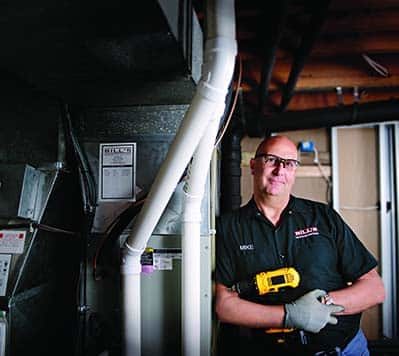How Does Propane Heat Work? | Propane Heating Systems
What is propane?
Propane — sometimes known as liquified petroleum gas, or LPG — is a gas normally compressed and stored as a liquid. As a type of hydrocarbon, it can undergo hydrocarbon combustion, which gives off heat. It is non-toxic, colorless, and virtually odorless; an identifying odor is added so it can be detected. Propane is commonly used for space and water heating, for cooking, and as fuel for engine applications such as forklifts, farm irrigation engines, fleet vehicles, and buses; however, its applications are rapidly growing due to new technology developments. When used as vehicle fuel, propane is known as propane autogas.
The Clean, Scientific Make-up of Propane
Propane’s chemical composition is C3H8, meaning it is composed of three carbon and eight hydrogen atoms. The majority of the molecule is hydrogen. That means that when propane combusts, the hydrogen atoms produce water vapor instead of the harmful emissions that are associated with other fuels. In fact, one molecule of propane contains about 72 percent hydrogen atoms, so most emissions simply become water vapor.
Propane burns cleanly because of its combustion process. Propane ignites when it comes in contact with oxygen, so there are no other chemicals involved in the process. Propane combustion produces a lot of heat, making it ideal for use in home appliances such as furnaces and water heaters. Plus, it produces less waste material than other combustion processes such as gasoline, so it is a great alternative fuel to use in vehicles. It’s a non-toxic, non-poisonous substance, so if spilled or released, it presents no threat to soil, surface water, or groundwater.
How Propane Produces Heat
A simple propane torch that is lit with a match will produce heat but since that’s not its primary purpose the torch is not an efficient heater. Some features are incorporated into a propane heater that directs the flame into a more efficient pattern for heating purposes and makes the heater more convenient to use.
Propane releases its chemical energy by undergoing hydrocarbon combustion. In residential use, it is stored under pressure inside a tank as a colorless, odorless liquid. As pressure is released, the liquid propane vaporizes and turns into gas that is used in combustion. Many propane heaters employ a so-called piezoelectric igniter. A material, often quartz crystal, which has the property of developing an electrical potential when pressure is applied is housed in a mechanism that allows a spring-loaded hammer to strike. This action generates a spark, igniting the propane.
Propane heaters feature some element, often porcelain, that spreads the flame out in a pattern and helps to distribute the fuel’s heat. A pilot light is a small flame that uses very little fuel and is designed to burn more or less continuously. Its purpose is to be ready to light the main burner relatively quickly rather than having to light the heater from scratch with the igniter each time.
Propane Systems in the Home
Many propane appliances, including fireplaces, kitchen ranges, and grills, showcase the open blue flame that is ignited. When it comes to your home heating system, propane furnaces convert the liquid propane stored in the tank into a gas that moves warmth across a heat exchanger. When this element reaches a set point, a blower will then transfer the heat across the heat exchanger before it is then distributed through the duct system. From there, it is distributed through vents to create a warm and cozy environment in your home or business.
Sources:
